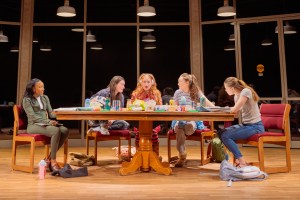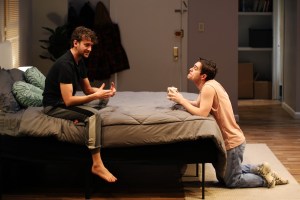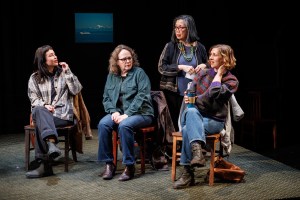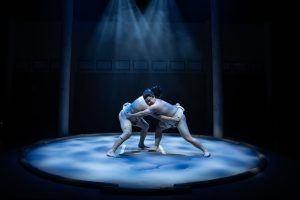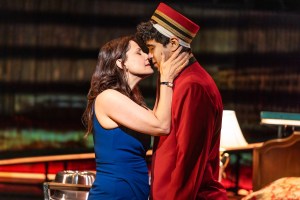
Considering that today’s theater audiences are primed to be excessive in their response to what they’re witnessing, so much so that standing ovations are increasingly de rigeur and a sitting ovation is tantamount to a tepid response, it’s puzzling that one reaction is almost never heard anymore: Booing.
The rarity of this response in the modern theater is even more mystifying when we consider that booing is a common occurrence in so many other venues. In sports, it goes on regularly; booing can even occur spontaneously when, for instance, a pitcher who has struck out eight innings’ worth of batters suddenly allows a home run. Mentioning that the catcall is a sine qua non at hockey games and at soccer games — in England, especially — is hardly necessary. Nor, on the other end of the gentility spectrum, is booing unknown at the opera. There, jeering claques have long been a tradition and vociferous behavior can still set off not-so-genteel verbal and physical contretemps.
There was a time when booing was frequently heard in theaters. Along with its sister reaction, hissing, it was not only expected but encouraged when Victorian melodramas — with their quivering heroines and mustache-twirling villains — were in vogue. The Great American Melodrama and Vaudeville, a company that has operated in Oceano, California for the last 28 years, even gives its eager patrons a booing warm-up before the curtain rises on productions of The Drunkard, Under the Gaslight, and The Streets of New York.
Booing predates the turn of the 20th century and may even go back to the Greeks. Certainly, there had to be booing and much worse on the streets of New York in May, 1849 when the Astor Place riots broke out, caused by the simultaneous engagements of American actor Edwin Forrest and British actor William Macready as competing Macbeths. Riled followers of the two thespians demonstrated their feelings so strongly that, before the outbreaks had died down, upwards of 20 theater lovers were dead. (Maybe Martin Scorsese should have put Daniel Day Lewis and Leonardo DiCaprio in a movie about that violent event in New York City history.)
Before 1849, events could be almost as deafening. When Charles Lamb’s farce Mr. H debuted at the Drury Lane in the first decade of the 19th century, Lamb himself joined the chorus of boos, supposedly claiming that he was “afraid of being taken for the playwright” if he failed to do so. And booing was a favorite pastime of Elizabethan crowds. How different could 16th century groundlings have been from the audiences at the New Globe who gleefully booed the French characters in the theater’s 1997 production of Henry V and gave Shylock what-for in a subsequent Merchant of Venice?
Booers aren’t completely unknown in contemporary theater. Several such people actively declared themselves during this year’s Third Annual Hip-hop Festival. One spectator insists that he sat amid booers at a Lincoln Center Theater matinee performance of Craig Lucas’s 1997 God’s Heart. When the musical Dude debuted in 1972, its quick fold was attributed by an observer to a preponderance of “passionate booing.” In 1968, Walter Kerr, writing about the Megan Terry-Tom O’Horgan Massachusetts Trust reported that one complaining patron was asked by another, “Are you going to boo at the end?” Told no, the man said, “Well, you should.” (For the record, Kerr doesn’t note whether either agitated seat-occupier followed suit.)
In general, however, booing is almost never heard nowadays. The reasons for the prevailing politesse are many. To begin with, Victorian melodramas are no longer in fashion; villains in contemporary dramatic literature may be myriad but they are not so black-and-white. Of course, the booing heard during performances of melodramas was aimed at characters, not at the actors playing them or at the playwright, the director, or any other member of the creative team. Therein may lie the main explanation for audience reticence: If theatergoers object to the quality of contributions made by one or more of the creators, the brunt of any booing would unfortunately have to be borne by the actors, who may have just done their utmost to make the best of a situation beyond their control. And political correctness, which continues to hold sway in this country, dictates that hurting the feelings of innocent parties is a no-no.
There are situations when the booing urge is activated by atrocious acting. In fact, it was my seeing two dreadful performances recently that got me thinking about booing as an option and wondering what holds people back. Yet I didn’t boo the abominable acting displays. Nor did anyone else in the audience, although it was clear that a significant percentage of those assembled shared my sentiments.

(Photo © Paul Kolnik)
I refrained from booing not because it’s no longer considered mannerly but, rather, because such a thing just isn’t done by reviewers. It’s incumbent on our crowd to refrain from indicating too openly, if at all, our take on a production while still in the auditorium; we’re expected to let our reactions be known in print or in front of the camera. Many critics even abstain from applauding and decline to join standing ovations, although they may eventually stand during the curtain call because it’s the only way to see what’s happening on stage.
But reviewers’ etiquette shouldn’t dictate how lay audiences behave. Perhaps it’s time for theatergoers to act on their booing inclinations if, indeed, they have them. In an era where road rage and other expressions of open hostility are rife, why shouldn’t audiences express theater rage? With ticket prices being what they are, there should be a way to show producers that the entertainment received has been far from commensurate with the money shelled out. If art represents the soul of civilizations, why not boo bad art as an assault on the collective soul?
Yes, booing can be a positive activity, but the question remains: How to do it without hurting innocent actors? Well, if an actor’s performance itself invites booing, then let ‘er rip when he or she steps out for a curtain call or after he or she finishes delivering a particularly lousy speech. Opera fans boo at the end of arias, and while the action of plays doesn’t stop at the end of monologues, there’s usually something of a pause while the content of the declaimed lines registers on the other actors. (In musicals, of course, boos can be mixed in with other people’s applause at the ends of songs.)
What’s the proper way to demonstrate dismay at a show’s direction, choreography, set design, and so on? This is a trickier matter. A set can be booed when the curtain rises if there are no actors already on it, but registering specific disapproval of sound or lighting design is much more difficult. A good time to boo absent perpetrators is at the end of an act; well-timed booing at this juncture can imply that it isn’t the performers but the general horribleness of the show that has triggered the negative vocal response.
But there’s an even better option. When a play is over and the lights have gone to black, there’s always a prolonged moment before the actors reappear for their bows. A solid round of booing at that precise moment can tell those behind the scenes that their work has ignominiously failed to pass muster. (Let the director, author, etc. sort out among themselves which of them is the target of the derision.) Then, when the actors come on, singly or as a group, they can be applauded and they’ll realize that they’re off the hook. There’s also the possibility of yelling out an individual name — the author’s, for example — followed immediately by a grating “Boo!” Yet another option is a perplexed cry of “Who wrote this?!” or “Did someone direct this?!”
And how do you boo a critic? That’s done in the form of letters, faxes, and e-mail — and it’s clear that theatergoers don’t need any instruction in this practice whatsoever.

